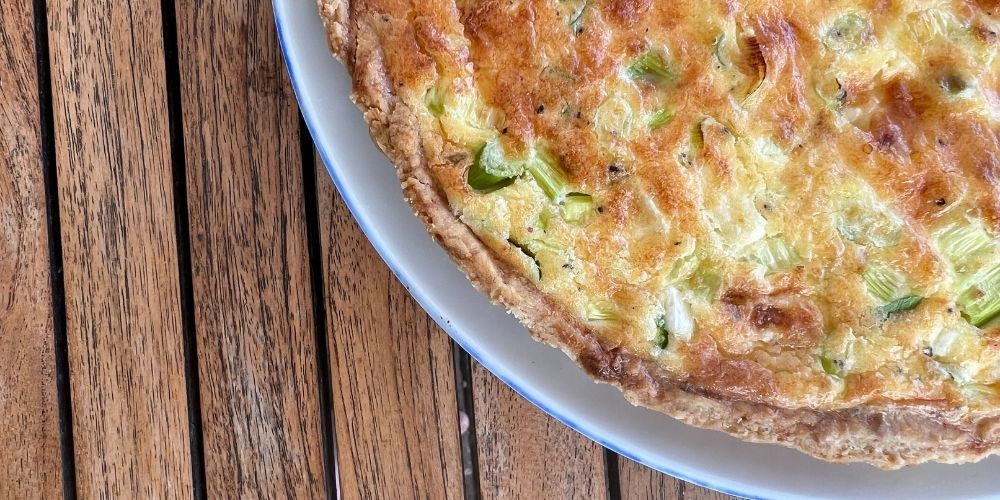
Cheeseboard quiche
Serves: 6
A staple dish for sunny summer suppers or classy picnics, the quiche is sometimes a slightly intimidating prospect for a home chef. This recipe calls for humble ingredients, such as eggs, cream and butter, plus whatever cheese you have in the bottom of the fridge – hence the name “cheeseboard quiche” I used a combination of aged gouda, ripe brie and a very crumbly mature cheddar, but you can use whatever you have to hand. P.S: If you’re short of time you can skip making your own pastry and use shop-bought. I won’t tell!
Cheeseboard quiche
Ingredients
- 100 g unsalted butter
- 185 g plain flour
- 3 tbsp ice-cold water
- 5 g finely-grated hard cheese such as parmesan
- 5 spring onions
- 200 ml cream preferably heavy/double/crème entière liquide
- 180 g cheese of your choice
- 3 eggs
Instructions
- You can make the pastry by hand, or in a food processor. To make it by hand, cut your cold butter into cubes and rub into the flour (plus a heavy pinch of salt) with your thumbs until the texture resembles fine breadcrumbs. Stir in the finely grated hard cheese until it’s well-dispersed. Then add just enough of the ice water (around 3 tablespoons) for it to form a cohesive dough. Too much and the pastry will be tough and stretchy. If you’re using a food processor, add your cubed butter, salt, hard cheese and flour to the bowl of the processor and pulse until you have the breadcrumb texture, then stream in the ice water while pulsing. Do not let the processor run for more than a second at a time or the dough will become warm, overheated and rubbery.
- Form a ball with your dough and place in the fridge to chill for at least an hour, or even overnight.
- Once your pastry is thoroughly chilled, roll it out as thin as you can manage and ease it into a well-greased fluted tart tin. You can use a little ball of spare pastry to press the rolled-out sheet into the grooved edges of the tin. Once you’re happy with how the pastry is sitting in the tin, gently cut off the excess, leaving a slight overhang in case of shrinkage. Chill the pastry case again for 30 minutes to allow the gluten to relax and the butter to harden. In the meantime, pre-heat your oven to 180C (fan).
- Remove your quiche case from the fridge and prick the bottom with a fork or skewer. Line the inside of the pastry with some greaseproof paper or baking foil and fill with blind baking beans or uncooked rice, to weigh it down while it cooks. This will prevent puffy, uneven pastry.
- Bake your pastry case in the oven for 20 minutes, then remove from the oven. Turn the temperature down to 160C (fan) and remove the lining and blind baking beans/rice, then return the pastry case to the oven for 10 minutes, or until light golden brown. Leave to cool in the tin.
- While your pastry is cooling, you can prepare your filling. How you incorporate the cheese will depend somewhat on which cheeses you are using. Sturdier cheeses can be grated, crumbly cheeses can be broken into smallish chunks and squashy, creamy cheeses can be cubed. As long as no pieces are much bigger than half a centimetre or so across you’ll be fine. Slice your spring onions (green and white parts) into rounds around 1-2mm wide.
- Lightly beat your eggs until well-combined. Avoid adding any air bubbles into the mix, as that will cause a grainy, puffy texture in the quiche filling. Add in the cream and mix until uniform in colour. Gently stir in the cheese, spring onions and a good pinch of salt and pepper.
- Pour your filling into the pastry case and – carefully – slide the quiche into the oven. Bake it at 190C (fan) for 20-25 minutes, or until the filling is gently set and lightly golden brown at the very edge.
- Cool your quiche in the tin for about 10 minutes, then release it from the tin and serve. It is delicious warm, preferably with a peppery salad and some boiled potatoes, but is still delicious cold.
Did you enjoy the recipe? Let us know in the comment section below.
Enjoy Taste of France? Well you’re in luck as Taste of France Issue Five is out of the oven!
Share to: Facebook Twitter LinkedIn Email




REPLY
REPLY
REPLY